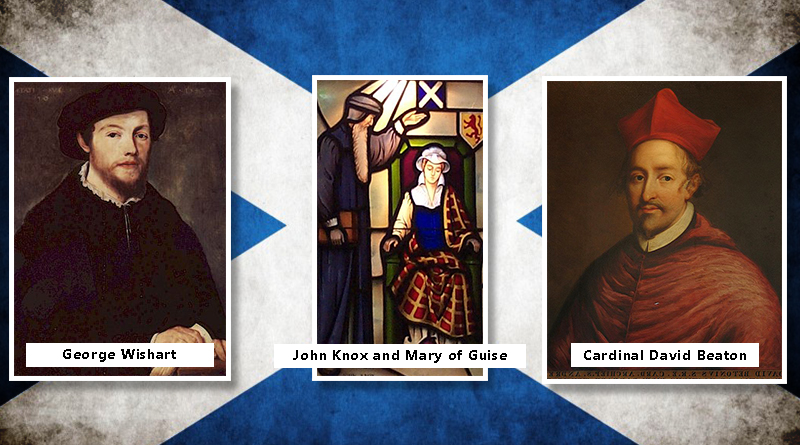George Wishart was born in 1513 and became one of the earliest Scottish religious reformers. Wishart is widely recognised as a martyr for his Protestant beliefs and was burned at the stake because of them in St Andrews on the orders of Cardinal David Beaton under accusations of heresy in 1546. George Wishart is best known in Dundee as the Protestant Reformation preacher who refused to stop preaching during a time of plague, when the town had closed its gates to prevent more infected from breaching the walls. Part of the original wall of the city still exists in the form of an arch named the Wishart Arch. Born to James Wishart and Elizabeth Learmont, he had a short but influential life, teaching as well as preaching in many different locations, including Europe and challenging the practices of the Christian Church at that time. During one of his preaching sessions, an assassination attempt was made against him. Cardinal Beaton was a powerful man, enraged by Wishart’s efforts to further the process of reform, and employed a priest to stab Wishart to death during one of his sermons. Thankfully for Wishart, he managed to not only disarm the priest, but also stopped the angry crowds from exacting their revenge on the would-be murderer.
Cardinal Beaton, whilst powerful, was not a man without sin himself, having allegedly fathered up to 20 children in addition to a sexual relationship with Marian Ogilvie. For Wishart and his sympathisers, Cardinal Beaton was the epitome of everything that was corrupt about the Church. Another attempt was made on Wishart’s life, but was again thwarted, much to Beaton’s fury. John Knox had become not only an avid supporter of Wishart, but also his bodyguard, confidante and tutor. Knox is believed to have followed Wishart everywhere with a large sword by his side, ready to defend his mentor to the death. The Cardinal was determined to wreak revenge on Wishart, eventually arresting him in 1546 with the help of Lord Bothwell. He was taken immediately to Elphinstone Castle, before being transferred to Edinburgh Castle. He finally arrived back at St Andrew’s Castle, under the orders of Cardinal Beaton, and was held in the dungeon prison pending trial. Accused of being an English spy and a heretic, Wishart was prosecuted by the Public Accuser of Heretics, John Lauder, who just happened to be Cardinal Beaton’s secretary. Regardless of Wishart’s responses to the accusations, he was found guilty and was sentenced to execution by burning at the stake.
On the morning of 1st March 1546, the day of his execution, it is reported that the keeper of St Andrews castle ate breakfast with Wishart and smuggled him gunpowder to put into his clothes so that he did not have to endure his fate by fire for too long. Upon meeting his executioner, it is said that the man begged Wishart for forgiveness. Wishart agreed to forgive the man for carrying out the sentence exacted upon him by the evil Cardinal, and the executioner fell to his knees with gratitude. George Wishart was hung by the neck and burned soon after, in what turned out to be a brutally gruesome display of torture. Whilst the gunpowder given to him by the keeper of the castle did explode, it did not have the intended effect of killing him outright, but instead, endured him further agony. Cardinal Beaton watched the horrific spectacle from a window of the castle, revelling in Wishart’s incredible suffering. Wishart finally succumbed to the agonising torment and died as his hanging body continued to burn.
The response to Wishart’s trial and execution was as swift as it was brutal. Less than three months after Wishart’s death, on the morning of 29th May 1546, a group of supporters entered St Andrews castle. Under the guise of labourers, they made their way to the Cardinal’s bedroom, killing anyone they encountered on their way. Cardinal Beaton was stabbed to death in his bedroom, mere minutes after Marion Ogilvie had left the castle. Upon his death, the group further defiled his corpse by stripping and mutilating it. To serve as a further warning, the Cardinal’s naked, bloody body was hung from the castle window, where it was displayed in a macabre saltire position for all to see. St Andrews Castle became a popular gathering place for Protestants from all over Scotland, including Wishart’s protégé, Knox. The Castle was defended from the forces of Mary of Guise for a year or so until its surrender in July 1547. When the castle was recaptured, the remains of Cardinal Beaton were found pickled in a barrel in the dungeon.
Legend would have it that the ghost of Wishart haunts the archway, and that sounds can be heard, as though a sermon is being taught. It is believed that George Wishart stood atop the Wishart Arch to preach to the infected on the outside of the town gates, but historians have shown that this particular wall was not erected during the time of Wishart, so it could not have been this wall he preached from and must have been another structure, since lost to time.
– DD Tours operates walking tours in Dundee city, covering dark local history such as wars, battles, murders, diseases, riots, disasters and executions. Walk with us for an unforgettable storytelling experience.
OR WHY NOT
